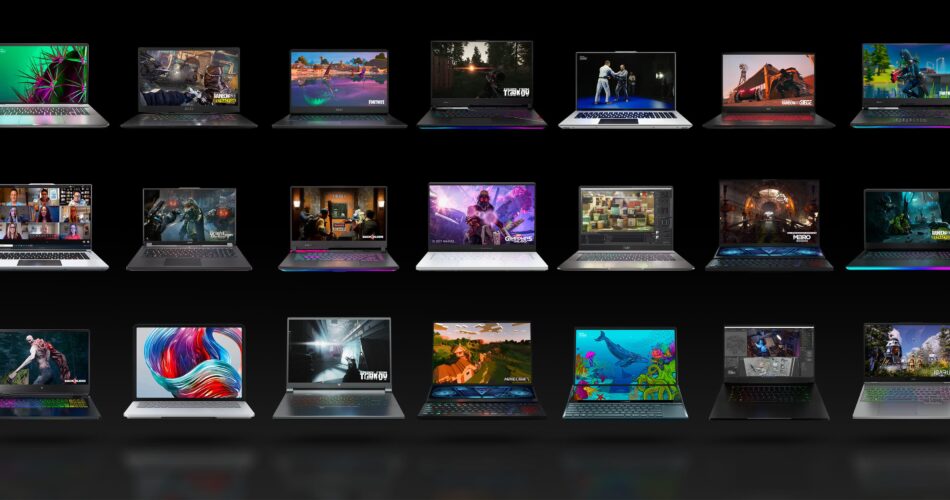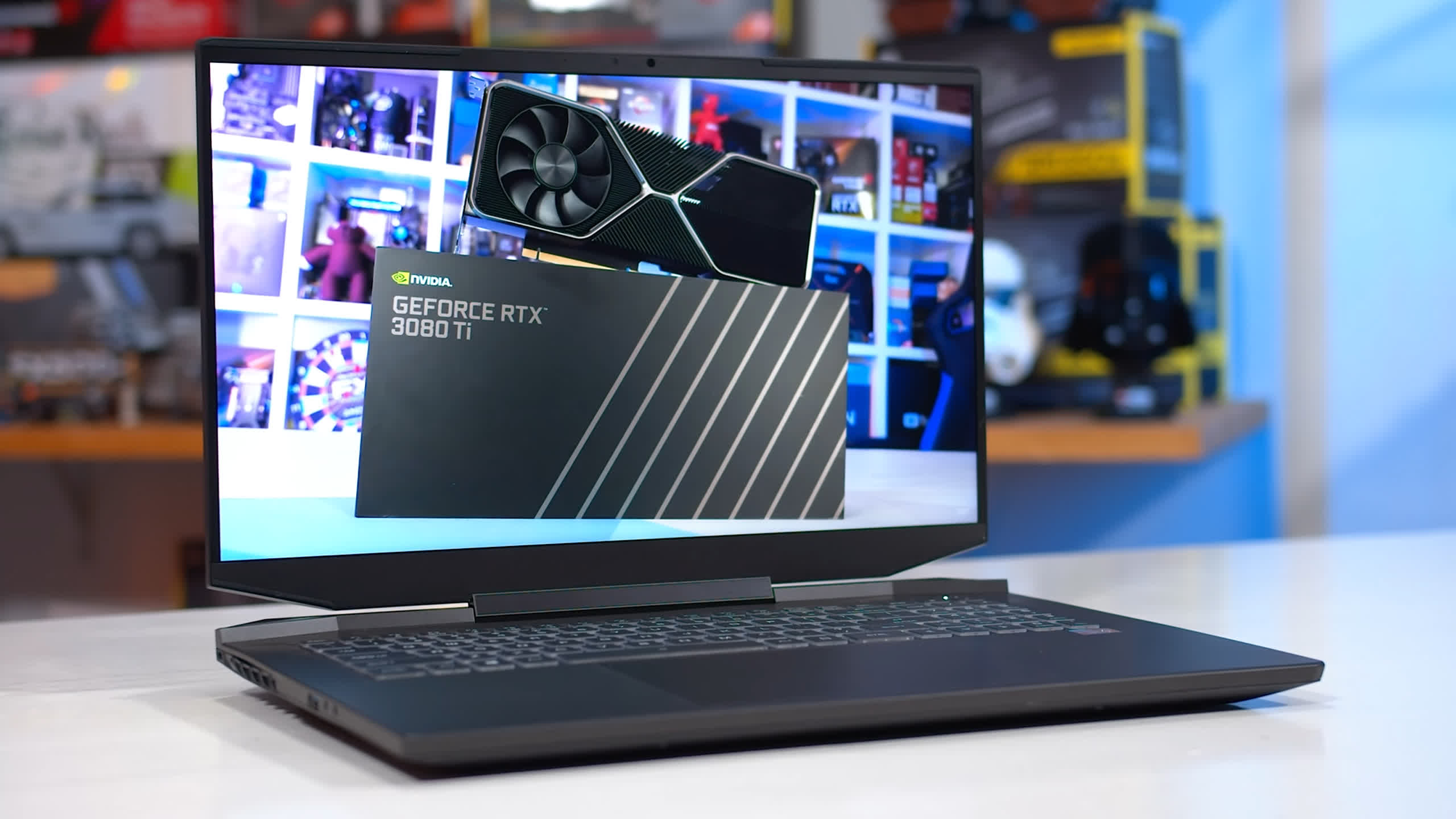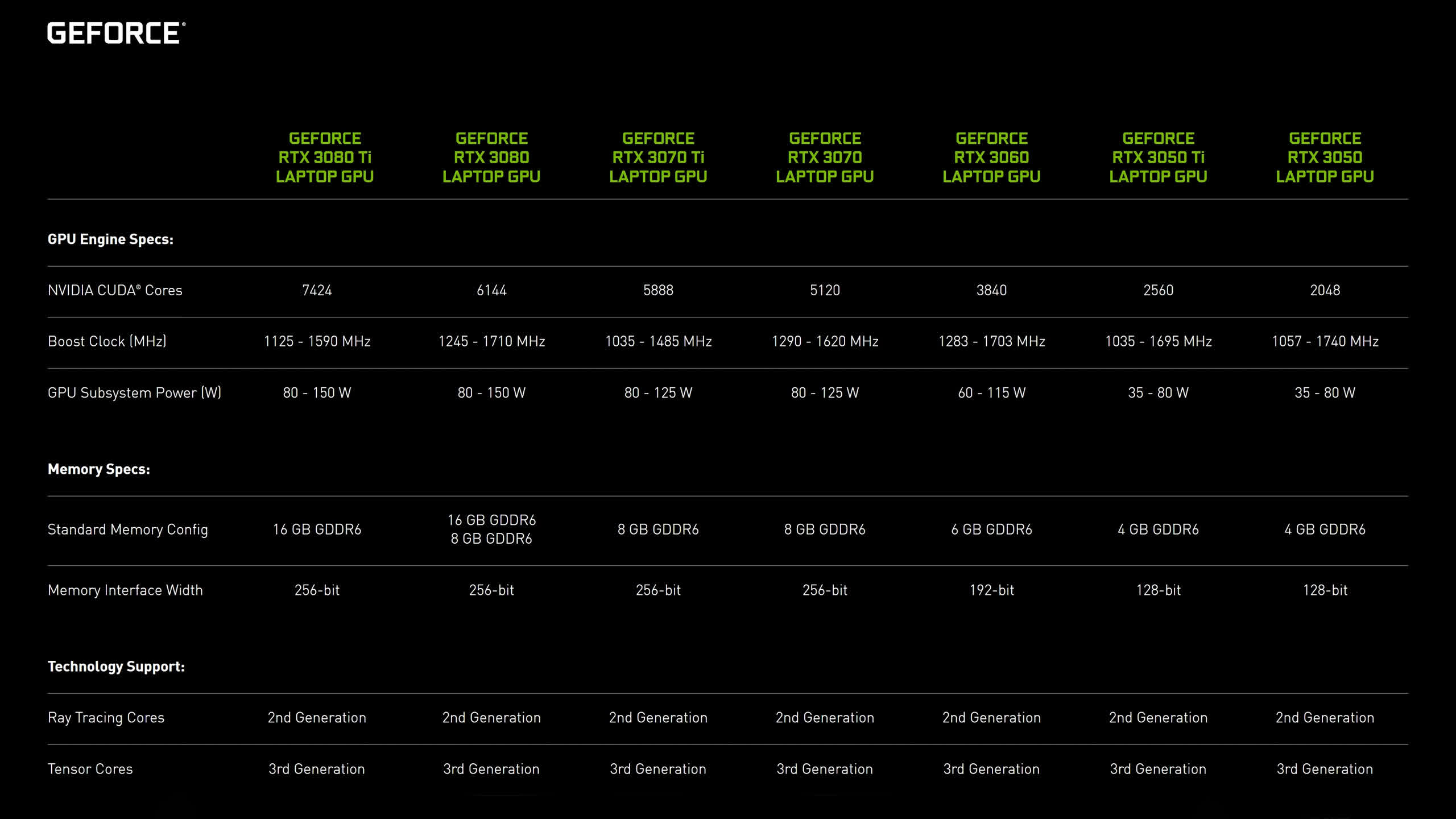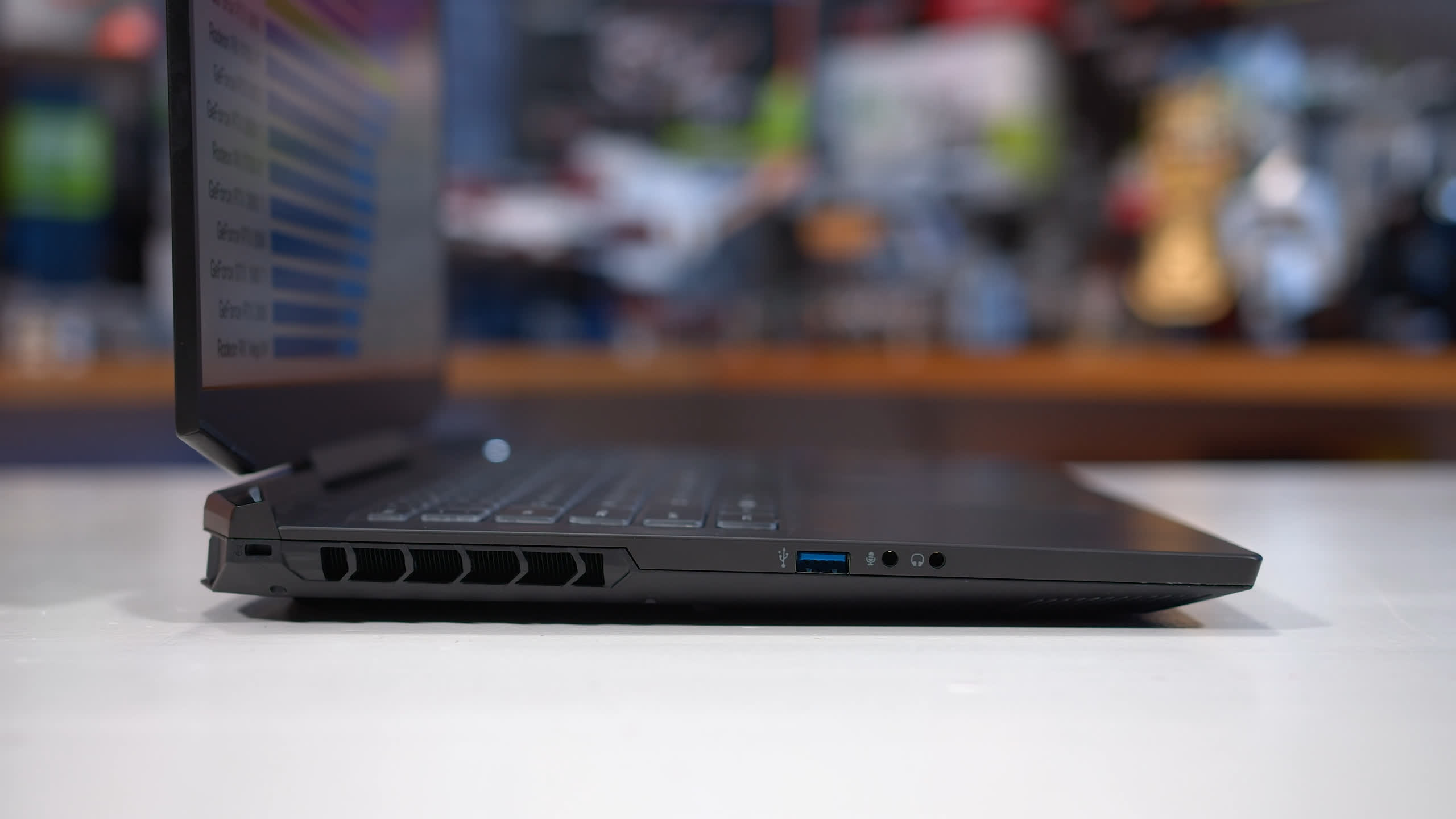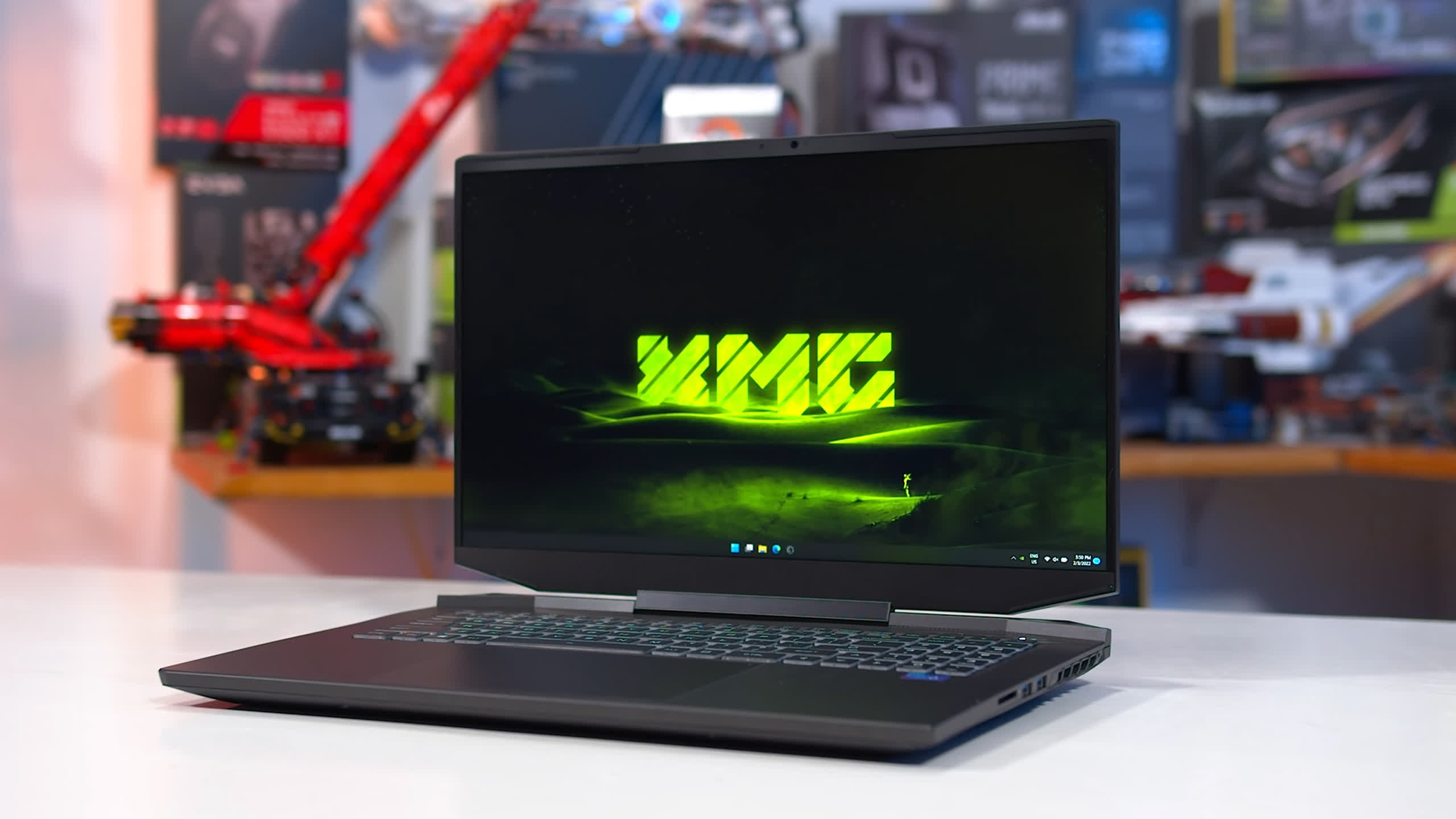Today we’re taking a quick look at the new GeForce RTX 3080 Ti GPU for laptops. The 3080 Ti represents a minor refresh to coincide with the latest range of gaming laptops powered by Intel Alder Lake and AMD Ryzen 6000 processors. It’s also the fastest laptop GPU Nvidia will be offering in early 2022, superseding the original RTX 3080.
The RTX 3080 Ti Laptop isn’t your typical refresh though, because Nvidia have create new silicon for this product, namely GA103. Before this, the largest die Nvidia were using in laptops was GA104 but this new GA103 die gives us access to more processing cores without the need to go all the way up to massive GA102 silicon, which would be somewhat impractical for laptop form factors.
On the spec sheet, there are two main improvements to the RTX 3080 Ti Laptop over the RTX 3080 Laptop chip. The new 3080 Ti packs 58 SMs, up from 48, which is a 21 percent increase and now gives us 7424 CUDA cores.
However, to fit inside similar 80-150W power limits, rated clock speeds have been dropped from a maximum of 1710 MHz boost down to 1590 MHz, so FP32 performance hasn’t increased by the full 20%. And while Nvidia does list up to 150W of available power, several laptop vendors will likely be offering this with up to 175W of power based on what we’re seeing.
The other main improvement is the memory speed, going from 14 Gbps to 16 Gbps GDDR6, and Nvidia is dropping the 8GB configuration to only offer 16GB of VRAM with the 3080 Ti Laptop chip. The same memory bus is used, but an increase in bandwidth and memory speeds now match AMD’s current line-up.
As an important side note, we’re still looking at a confusing situation where the RTX 3080 Ti Laptop GPU is not the same as the desktop RTX 3080 Ti card, and it’s not even close.
The desktop model packs 80 SMs, higher boost clock speeds, and faster GDDR6X memory on a wider bus. So despite sharing the same name, it feels a bit misleading to call the laptop GPU a “3080 Ti” when the desktop model has 38% more CUDA cores and many other advantages. Not going to harp on this point much further, but it’s something to be aware of.
Our test platform for today’s review was provided by XMG, this is one of the laptops we used for reviewing the new Intel Core i7-12700H CPU which is based on the Alder Lake architecture.
The XMG GM7AG8M 17-inch chassis we have on hand runs on that Intel processor, plus 32GB of DDR5 memory in a dual-stick configuration. The RTX 3080 Ti Laptop GPU is configured at 150W with 5W of dynamic boost, but just to be clear, there are multiple configurations of the RTX 3080 Ti that will all have the same advertised name, but different power limits.
An 80W configuration in a slimmer, smaller laptop will be significantly slower than the results we show today, which are representative of high-power flagship laptops.
In addition, this machine offers a nice 1440p 240Hz IPS display and I’m loving this shift towards 1440p displays for new generation laptops as these GPUs should be good enough to handle them.
For testing we’ll be benchmarking and comparing GPUs at 1080p, with the display connected to the iGPU. This is the most limited configuration and is how many laptops are run in a hybrid or Optimus mode. Then we also have 1440p results with the GPU connected directly to the display, which is the most GPU limited and representative of laptops with a mux switch (to enable or disable the integrated graphics) or external display use.
Gaming Benchmarks
Let’s kick off testing with Watch Dogs Legion. Running at 1080p using Ultra settings, the RTX 3080 Ti Laptop is a highly capable GPU offering 13% higher performance than the RTX 3080 Laptop, though at a slightly higher power usage in practice from a similar power range.
But we’re very much sitting in the range of mid-range to high-end desktop configurations, falling just 13% short of a desktop RTX 3080 configuration we tested earlier. This is well behind the real RTX 3080 Ti for desktops, but similar to what is possible from an RTX 3070.


At 1440p, the gap between the RTX 3080 and RTX 3080 Ti laptop models closes, and the gap widens to the desktop RTX 3080. The 3080 Ti for laptops is slightly faster, but it’s kinda negligible at just a 4% margin. With that said, this laptop GPU is good for over 60 FPS on average using ultra settings, which is a very playable frame rate for this sort of title.

In Metro Exodus we find something a bit different. Our RTX 3080 Ti configuration is a little behind the RTX 3080 laptop model, by just a few frames – and this is despite the new Alder Lake CPU being faster for gaming than previous 11th-gen parts.
To me this suggests the game might be favoring frequency and that shift in going up in CUDA cores but down in frequency versus the 3080 might be hurting here. It’s also possible that given the overall power budget, which now needs to factor in higher clocked and more power consuming memory potentially at the cost to GPU power, things just haven’t quite aligned in favor of the Ti model.

And this isn’t an outlier at 1080p, it’s also the case at 1440p where Metro Exodus is still very GPU limited using Ultra settings. That’s a disappointing regression for the new Ti model but this wasn’t the case with most other games tested.


In Red Dead Redemption 2, the RTX 3080 Ti does pretty well compared to the RTX 3080 in average frame rates, despite a small regression in 1% low numbers. The new Ti model is 10% faster at 1080p, but not really at the level of a desktop system equipped with a powerful RTX 3080 GPU. Meanwhile at 1440p, the RTX 3080 Ti is merely matching the RTX 3080’s average performance in a laptop, making the new Ti model rather pointless.

Cyberpunk 2077 is the other game we tested where the RTX 3080 Ti laptop configuration we used was slower than our previous RTX 3080 system from MSI, despite what should be a more favorable overall platform. The difference is very small, just a few FPS in total, but I would have expected the new Ti refresh to be in the range of 5-10% faster in this very performance intensive game. Not saying it performs badly or anything as you can easily get over 60 FPS at 1080p, but comparatively it’s a bit disappointing.

At 1440p it slips a few FPS behind the RTX 3080 Laptop model, though it’s still enough performance to match AMD’s Radeon RX 6800M in a similar power range. Unfortunately for those wanting to buy a laptop as a desktop replacement, the new RTX 3080 Ti in Cyberpunk is 33% slower than the desktop RTX 3080, let alone the RTX 3080 Ti – you simply can’t match a 320W desktop GPU with just 150W of available power.

In Horizon Zero Dawn, the RTX 3080 Ti is 7% faster in average frame rates when compared to the RTX 3080 at 1080p, so that’s a small but respectable result, and not a regression like in two of the games we’ve looked at so far. This keeps the 3080 Ti a decent margin ahead of AMD’s RX 6800M and other GPUs.

Meanwhile at 1440p, the margin between the 3080 and 3080 Ti closes to just a few FPS, which is negligible. Performance is excellent in general, offering 100 FPS at 1440p using the highest quality preset, and the margin is smaller versus the desktop RTX 3080 compared to other games which is nice to see.


Some games on a laptop are going to be more CPU limited than others. Rainbow Six Siege is one such example at 1080p, where most of the gains seen here are attributable to the new Intel 12th-gen CPUs.
As I expect pretty much all RTX 3080 Ti laptops to feature new generation CPUs, this is definitely a benefit to a new laptop vs a last-gen model, but it may not necessarily be the GPU alone that is doing the work. For example, at 1440p in this same game, the margin between systems closes up a fair bit and the benefit to getting the new 3080 Ti model with a 12th-gen CPU drops to just 5% in terms of 1% low performance, not 25% like we saw at 1080p.


Another example of a CPU limitation is Hitman 3. At 1080p these sorts of laptops can quickly run into a wall when you have a fast enough GPU – the 12700H is providing most of the huge 30% performance gains we see over the last-gen RTX 3080 configuration, even beating our desktop test result for the 3080.
But at 1440p, the GPU becomes much more relevant, and now the margin between the 3080 Ti and 3080 shrinks to just a few percent in favor of the new Ti model.

We’re still working on some new game benchmarks that we’ll be using across 2022’s laptop GPU comparisons but here’s a sneak preview of how the RTX 3080 Ti Laptop GPU fares.

In Forza Horizon 5 using the Ultra preset at 1440p we see an average frame rate of 90 FPS, another great result that makes this GPU well suited to smooth gameplay.

In Guardians of the Galaxy at 1440p, the 3080 Ti is very impressive, pushing over 120 FPS using the Ultra preset which is highly playable on new laptop displays.

In Deathloop once again using Ultra settings, we see a similar result with 90 FPS highly achievable which is more than enough for this sort of title.

Then for ray tracing performance, in Guardians of the Galaxy, the RTX 3080 Ti laptop GPU can hit a 60 FPS average using the highest quality ray tracing settings at 1440p without using DLSS, so that’s very solid levels of performance and can only go up from there should you choose to enable DLSS Quality for example.

Far Cry 6 ray tracing is also highly playable and the large 16GB VRAM buffer prevents any stuttering issues at 1440p, which is an issue with the RTX 3070 laptop configuration as you can see in the chart.
What We Learned
Overall, the RTX 3080 Ti is a very capable GPU for gaming laptops and was able to put up 60 FPS or near to 60 FPS in basically all of the games we tested, even at 1440p using high or ultra settings.
In some games it can even do quite a bit better than that, offering a medium or high refresh rate experience without sacrificing much from visuals. In isolation, a product like the 3080 Ti Laptop is well suited to this new generation of 2022 laptops that will be more often featuring 1440p displays, mux switches, and large performance gains for the CPU.
However, it also doesn’t seem like a very necessary or revolutionary upgrade for the laptop market. Despite being technically crowned the “fastest” laptop GPU you can get, it’s only marginally faster than the RTX 3080 for laptops in a similar power class – around 10% better at 1080p, and only ~5% faster at 1440p. In two of the games tested, it ended up slower than the RTX 3080 laptop configuration, which was disappointing to see, though I expect this to be an outlier and not the norm.
This kind of small performance gain presents a situation for laptop buyers. If you can find an RTX 3080 Ti laptop with a similar configuration at the same price as an older RTX 3080 laptop, we see no issues at all. You’ll also almost certainly benefit from new platform advantages, like an upgraded CPU and better display.
But for pure gamers, I’d find it hard to recommend an RTX 3080 Ti laptop if it was more expensive than an RTX 3080 system, which usually are expensive enough as is. The performance gains are minor and if a newer system with the Ti was more expensive, you’d definitely want it to feature a faster CPU and come with other benefits like more RAM or SSD space.
We should note, these margins aren’t too different to what is seen on the desktop side, where the RTX 3080 Ti is less than 10% faster than the RTX 3080, so the laptop market is also seeing the typical very marginal gains at the high end wallet-gouging segment. But we do want to reiterate that the RTX 3080 Ti GPU on laptops is nowhere near as fast as the RTX 3080 Ti for desktops, and ends up 20 to 30 percent slower than the RTX 3080 desktop GPU in most cases — there’s no substitute for desktop gaming power if sheer performance is what you’re after.
The RTX 3080 Ti for laptops is closer to the RTX 3070 desktop GPU based on our testing, which is no slouch of a card. The 3070 is very good, but it’s just at the top of the desktop market.
Shopping Shortcuts
Source link


